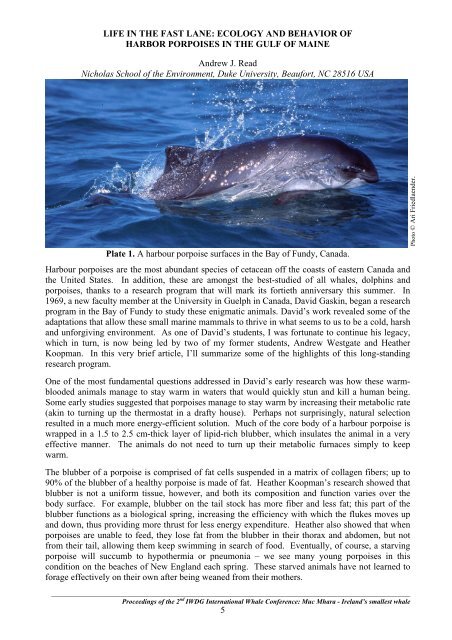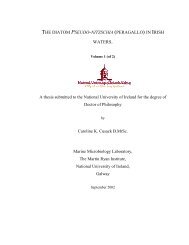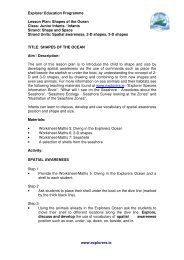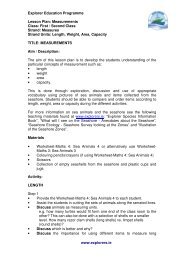Muc Mhara Ireland's Smallest Whale - Marine Institute Open Access ...
Muc Mhara Ireland's Smallest Whale - Marine Institute Open Access ...
Muc Mhara Ireland's Smallest Whale - Marine Institute Open Access ...
You also want an ePaper? Increase the reach of your titles
YUMPU automatically turns print PDFs into web optimized ePapers that Google loves.
LIFE IN THE FAST LANE: ECOLOGY AND BEHAVIOR OF<br />
HARBOR PORPOISES IN THE GULF OF MAINE<br />
Andrew J. Read<br />
Nicholas School of the Environment, Duke University, Beaufort, NC 28516 USA<br />
Plate 1. A harbour porpoise surfaces in the Bay of Fundy, Canada.<br />
Harbour porpoises are the most abundant species of cetacean off the coasts of eastern Canada and<br />
the United States. In addition, these are amongst the best-studied of all whales, dolphins and<br />
porpoises, thanks to a research program that will mark its fortieth anniversary this summer. In<br />
1969, a new faculty member at the University in Guelph in Canada, David Gaskin, began a research<br />
program in the Bay of Fundy to study these enigmatic animals. David’s work revealed some of the<br />
adaptations that allow these small marine mammals to thrive in what seems to us to be a cold, harsh<br />
and unforgiving environment. As one of David’s students, I was fortunate to continue his legacy,<br />
which in turn, is now being led by two of my former students, Andrew Westgate and Heather<br />
Koopman. In this very brief article, I’ll summarize some of the highlights of this long-standing<br />
research program.<br />
One of the most fundamental questions addressed in David’s early research was how these warmblooded<br />
animals manage to stay warm in waters that would quickly stun and kill a human being.<br />
Some early studies suggested that porpoises manage to stay warm by increasing their metabolic rate<br />
(akin to turning up the thermostat in a drafty house). Perhaps not surprisingly, natural selection<br />
resulted in a much more energy-efficient solution. <strong>Muc</strong>h of the core body of a harbour porpoise is<br />
wrapped in a 1.5 to 2.5 cm-thick layer of lipid-rich blubber, which insulates the animal in a very<br />
effective manner. The animals do not need to turn up their metabolic furnaces simply to keep<br />
warm.<br />
The blubber of a porpoise is comprised of fat cells suspended in a matrix of collagen fibers; up to<br />
90% of the blubber of a healthy porpoise is made of fat. Heather Koopman’s research showed that<br />
blubber is not a uniform tissue, however, and both its composition and function varies over the<br />
body surface. For example, blubber on the tail stock has more fiber and less fat; this part of the<br />
blubber functions as a biological spring, increasing the efficiency with which the flukes moves up<br />
and down, thus providing more thrust for less energy expenditure. Heather also showed that when<br />
porpoises are unable to feed, they lose fat from the blubber in their thorax and abdomen, but not<br />
from their tail, allowing them keep swimming in search of food. Eventually, of course, a starving<br />
porpoise will succumb to hypothermia or pneumonia – we see many young porpoises in this<br />
condition on the beaches of New England each spring. These starved animals have not learned to<br />
forage effectively on their own after being weaned from their mothers.<br />
_________________________________________________________________________________________________________<br />
Proceedings of the 2 nd IWDG International <strong>Whale</strong> Conference: <strong>Muc</strong> <strong>Mhara</strong> - Ireland’s smallest whale<br />
5<br />
Photo © Ari Friedlaender.





